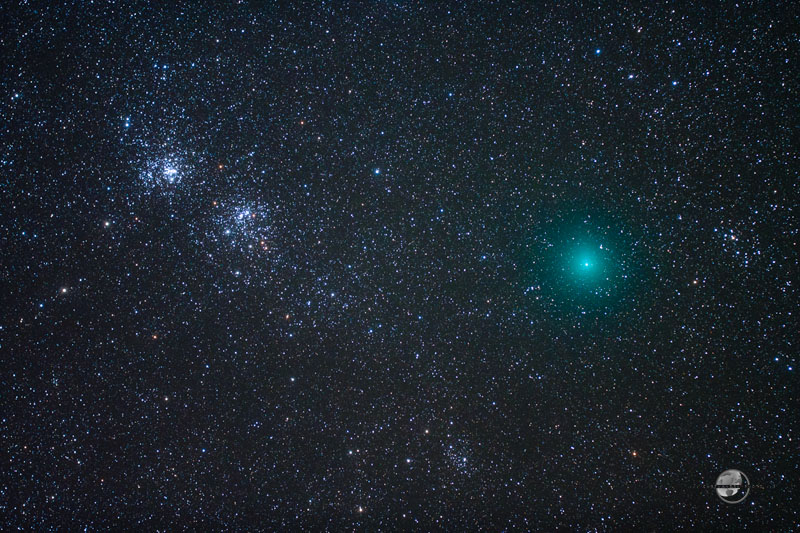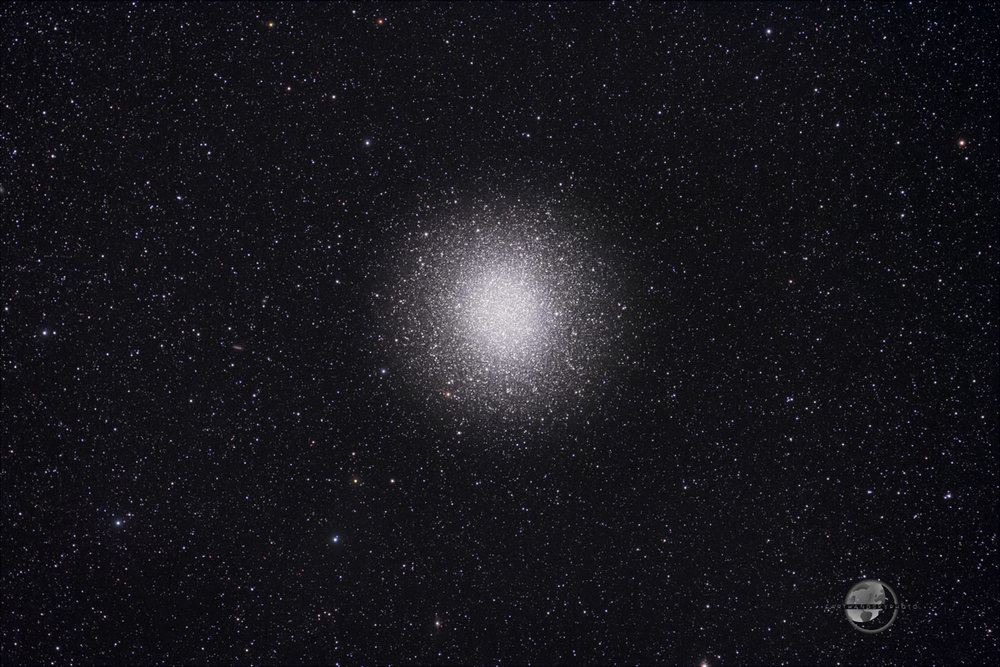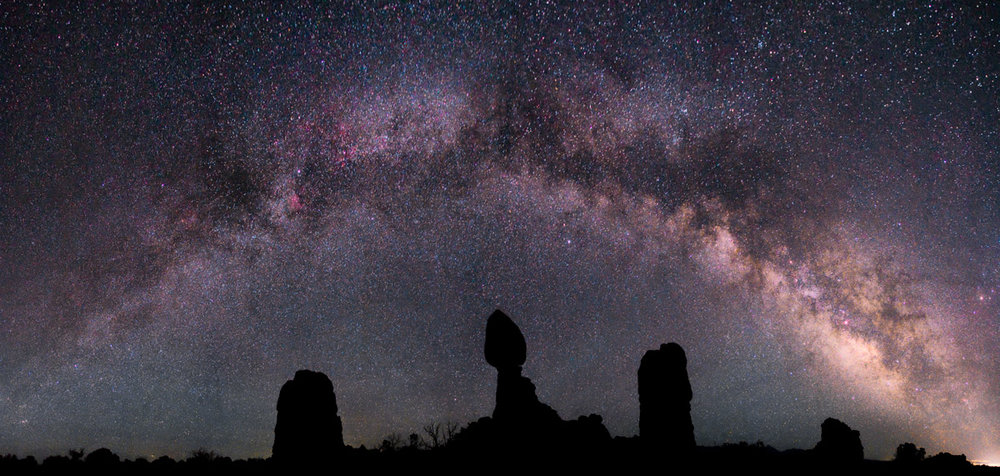 Comet Hartley and the Double ClusterThis image was taken from Spruce Knob in the highlands of West Virginia on October 9 at 1:00 a.m. The image shows the green glow of Comet Hartley 2 as it graces our neighborhood of the solar system on its latest journey to the sun. Also in the picture is the deep sky object known as the Double Cluster. The cluster is made up of two distinct open clusters of stars and are also know as NGC 869 and 884. The comet was visited by the EPOXI Mission spacecraft on November 4 and the amazing images from that visit are featured on this APOD page. The comet's closest approach to Earth was 11 million miles on October 28 and will visit our neighborhood again in April 2017.
Comet Hartley and the Double ClusterThis image was taken from Spruce Knob in the highlands of West Virginia on October 9 at 1:00 a.m. The image shows the green glow of Comet Hartley 2 as it graces our neighborhood of the solar system on its latest journey to the sun. Also in the picture is the deep sky object known as the Double Cluster. The cluster is made up of two distinct open clusters of stars and are also know as NGC 869 and 884. The comet was visited by the EPOXI Mission spacecraft on November 4 and the amazing images from that visit are featured on this APOD page. The comet's closest approach to Earth was 11 million miles on October 28 and will visit our neighborhood again in April 2017.
astronomy
Andromeda Galaxy 2010
 The Great Andromeda GalaxyIf you have followed previous blog posts you know that I have been working on this image for some time. I apologize that I did not provide more intermediate updates, but here is the final image as it will be printed on my Epson 7800. You may want to reference earlier posts about making a print of Andromeda beginning on September 15. You can see the initial RAW image at initial capture and compare to the finished image. As Ansel said, "you don't take a photograph, you MAKE a photograph."
The Great Andromeda GalaxyIf you have followed previous blog posts you know that I have been working on this image for some time. I apologize that I did not provide more intermediate updates, but here is the final image as it will be printed on my Epson 7800. You may want to reference earlier posts about making a print of Andromeda beginning on September 15. You can see the initial RAW image at initial capture and compare to the finished image. As Ansel said, "you don't take a photograph, you MAKE a photograph."
It is always a pleasure to revisit familiar astronomical objects and the Great Andromeda Galaxy is certainly one of the finest. This past August we had the opportunity to capture the galaxy from the fabulous dark skies of The Mountain Institute on Spruce Knob in West Virginia during the Almost Heaven Star Party. The galaxy is a marvel to behold as one of our local neighborhood galaxies that stretches over 220,000 light years across. It is the farthest deep sky object that can be seen with the unaided eye and is located at a distance of over 2,000,000 light years away. The galaxy is easily seen from the dark skies of Spruce Knob with the unaided eye. The diffuse glow of the galaxy is caused by billions of stars shining throughout the galaxy's disk. Andromeda is classified as a spiral type of galaxy. For more information and to view the image in the black portfolio screen (the best view) please click here.
The Granddaddy of Them All
 Omega CentauriThe grand-daddy of them all. The globular cluster in Centaurus is the biggest and brightest in the Milky Way Galaxy. It is estimated that over 10 million stars are rotating around the cluster's core. The cluster is designated as NGC 5139 on star charts and lies over 18 thousand light years away. The cluster is 150 light years across and is estimated to be over 12 billion years old! It is a glorious sight in a telescope and is best viewed from southern latitudes. This image was taken during the 2010 Winter Star Party in the Florida Keys.
Omega CentauriThe grand-daddy of them all. The globular cluster in Centaurus is the biggest and brightest in the Milky Way Galaxy. It is estimated that over 10 million stars are rotating around the cluster's core. The cluster is designated as NGC 5139 on star charts and lies over 18 thousand light years away. The cluster is 150 light years across and is estimated to be over 12 billion years old! It is a glorious sight in a telescope and is best viewed from southern latitudes. This image was taken during the 2010 Winter Star Party in the Florida Keys.
Technical details: Images were acquired with a modified Canon T1i on a Takahashi 85 FSQ with focal reducer. The tracking mount used was an Astro-Physics Mach1 GTO. Images were converted in Adobe Light Room 3.0, combined with DeepSky Stacker, and enhanced in Adobe Photoshop CS5. There are approximately 60 images combined with varying ISOs to obtain the final image.
The image may be seen in larger portfolio presentation in the Color Astrophotography Gallery.
Milky Way Over Balanced Rock
 Milky Way Over Balanced RockLight from the center of the Milky Way Galaxy is roughly 20,000 light years away. There is no better place to take in that ancient light than from the American Southwest where Earth's ancient rocks create wonderful foregrounds in which to view the Milky Way. This image is a 7 frame stitch from Arches National Park in June 2010. The image is located in the Color Astronomical Gallery at the bottom of the page.
Milky Way Over Balanced RockLight from the center of the Milky Way Galaxy is roughly 20,000 light years away. There is no better place to take in that ancient light than from the American Southwest where Earth's ancient rocks create wonderful foregrounds in which to view the Milky Way. This image is a 7 frame stitch from Arches National Park in June 2010. The image is located in the Color Astronomical Gallery at the bottom of the page.
I am not sure what the radiating rays of light may be. They seem to be originating from Balanced Rock. Perhaps a very dim source of light or some atmospheric phenomena.
This image is not available as a fine art print.
New Jupiter Impact Image by Two Amateur Astronomers
Two amateur astronomers captured a new impact event on Jupiter June 3. Anthony Wesley of Australia and Christopher Go of the Philippines have independently observed an impact event on Jupiter. For more information please see spaceweather.com.
